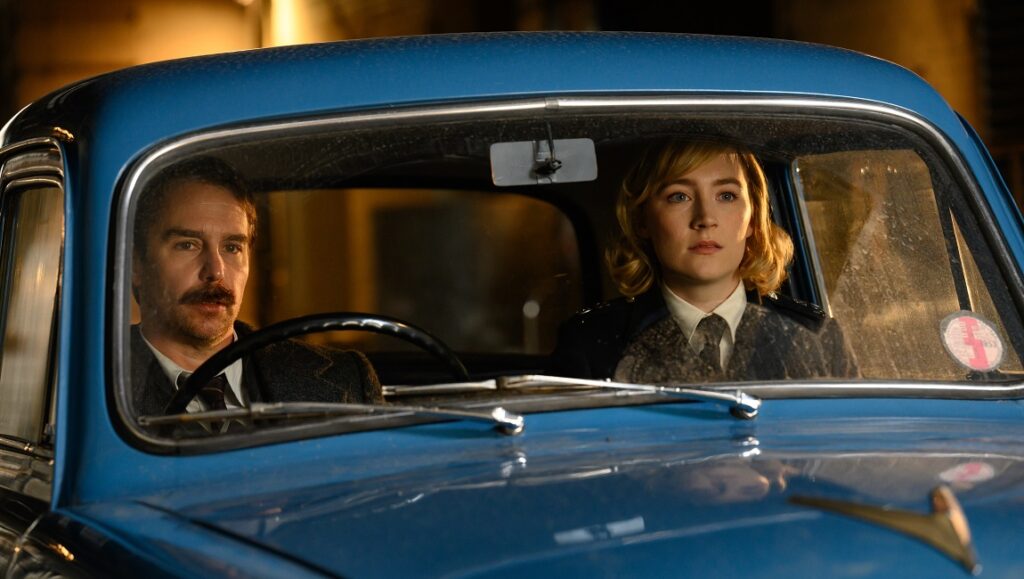See How They Run is an amiable, nerdy romp that draws upon theater history, Agatha Christie, and even Wes Anderson to create a jaunty exercise in controlled chaos.
One of London’s best-kept secrets isn’t a rave, restaurant, or racetrack tip — it’s the plot of Agatha Christie’s play The Mousetrap. Its nearly 70-year run was interrupted due to Covid shutdowns, but has since re-opened, along with its tradition of secrecy: after each performance audiences are sworn to keep the play’s twist to themselves. BBC director Tom George borrows this and many other historically accurate tidbits for his first feature film, See How They Run, a tongue-in-cheek whodunnit set in 1953, just a year after the play debuted on the West End. Not that anyone related to the play was murdered in real life — this isn’t Macbeth, after all. But Christie really did stipulate that no film version could be released until six months after The Mousetrap concludes its run, a major plot point in the film. And a young Richard Attenborough, here portrayed as a verbose hunk by Harris Dickinson, really did star in the play’s original run.
George furnishes audiences with all the familiar whodunnit ingredients: an ensemble cast of actors, producers, and sycophants; a world-weary detective; a nondescript “village idiot” who’s revealed as the unlikely mastermind; and, cynically recounting every twist and turn, the jaded voiceover. All of this is in itself recounted via additional jaded voiceover by the ghost of Leo Köpernick (Adrien Brody), a semi-disgraced American director who’s hired to adapt the play for Hollywood and is murdered during its 100th-performance afterparty after running afoul of nearly everyone important. The film’s star-studded ensemble cast includes adulterous producer John Woolf (Reece Shearsmith) and his secretary-turned-mistress Ann (Pippa Bennett-Warner), ruthless theater owner Petula Spencer (Ruth Wilson), simpering screenwriter Mervyn Cocker-Norris (David Oyelowo) and his Italian loverboy Gio (Jacob Fortune-Lloyd), and Dickie Attenborough’s wife, Sheila Sim (Pearl Chanda).
But cutting through the thick of characters and wink-wink-nod-nod flourishes are the two members of Scotland Yard assigned to the case: grizzled Inspector Stoppard (Sam Rockwell) and the bright-eyed and bushy-tailed thorn in his side, Constable Stalker (Saoirse Ronan). With her penchant for overzealous note-taking (“don’t..jump..to..conclusions”) and his hankering for midday pub breaks, their unlikely buddy-cop dynamic is the film’s main source of humor. As the young, female eager beaver, Ronan plays Stalker as more Judy Hopps than Hermione, fond of puns and nervous chatter but never falling on the wrong side of know-it-all. Her comedic timing and poker-faced delivery are excellent even if her jokes are occasionally groan-worthy. Meanwhile, Rockwell imbues Stoppard with weary melancholy as befits a man who’s been deserted by his wife and underappreciated by his commissioner. This gravity is somewhat of a departure from the affected primness that Christie fans have come to associate with her more famously mustachioed detective.
In fact, in tone and aesthetic, See How They Run could well be mistaken for a minor Wes Anderson romp: there are plenty of symmetrical shots, two- and four-way split-screens, and pleasantly twee production design (patterned silk ascots abound.) But the subject matter is deliciously nerdy, and George (and screenwriter Mark Chappell) have a palpable affection for both their story and the long theater history from which they’ve drawn. It’s all rather polite and proper, if not a little silly — just note the gags and feints in Köpernick’s murder scene, including an exit door that opens to a brick wall — so it’s fitting that the final set piece swaps London for the country estate of Dame Agatha Christie herself. As the film reaches its climax, it starts to resemble that other quintessentially British pastime, the hedge maze — a winding exercise in controlled chaos, where the most direct route to the center might require skirting the periphery rather than plunging in headfirst.


Comments are closed.